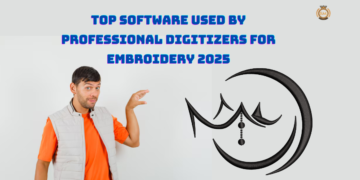Creating stunning embroidery designs starts with the right tools, and a digitizer for embroidery relies on powerful software to turn artwork into stitch-ready files. Professional digitizers use specialized programs to ensure precision, versatility, and efficiency, whether crafting logos, patterns, or custom designs. For embroiderers looking to understand or adopt pro-level tools, knowing the best software is key. This guide highlights the top options used by experts in 2025.
In this blog, we’ll explore leading embroidery digitizing software, their features, and how they compare to professional embroidery digitizing services like EMDIGITIZING. Let’s dive into the tools that power professional embroidery.
What Does Embroidery Digitizing Software Do?
A digitizer for embroidery uses software to convert images into digital files (e.g., DST, PES, EXP) that embroidery machines read. These files dictate stitch types, density, and paths to create clean, durable designs on fabric. Professional software offers advanced tools for editing, previewing, and optimizing designs, ensuring high-quality results.
Unlike basic programs, pro-level software handles complex tasks like logo digitizing, 3D puff effects, and fabric-specific adjustments. While professionals often use these tools, services like EMDIGITIZING provide an alternative for those who prefer outsourcing.
Why Professional Digitizers Choose Specialized Software
Professionals demand software that delivers precision and flexibility. Here’s why they opt for top-tier programs over free or basic tools:
- Accuracy: Fine-tune stitches for intricate details like small text or gradients.
- Versatility: Support for multiple file formats and fabric types.
- Efficiency: Streamlined workflows to handle bulk or complex projects.
- Advanced Features: Tools for 3D effects, appliqué, or custom stitch patterns.
These programs empower digitizers to meet client needs, but they require skill and investment. Let’s explore the top software choices driving professional embroidery.
1. Welcome Embroidery Studio
Wilcom EmbroideryStudio is the gold standard for professional digitizers, known for its robust features and industry-wide use. It’s a favorite for creating high-quality files for logos, apparel, and decorative designs.
Key Features
- Advanced Editing: Adjust stitch density, underlay, and pull compensation.
- Multi-Format Support: Outputs files for all major machines (DST, PES, etc.).
- 3D Puff and Appliqué: Ideal for bold, textured designs.
- Auto-Digitizing: Converts images to stitches with manual refinements.
- Design Library: Organize and reuse files for efficiency.
Pros
- Handles complex designs with precision.
- Extensive tutorials and community support.
- Trusted by large embroidery businesses.
Cons
- High cost ($1,000-$4,000, depending on version).
- Steep learning curve for beginners.
Best For
Professional digitizers working on high-volume or intricate projects, like corporate branding or fashion embroidery.
2. Hatch Embroidery
Hatch Embroidery, by Wilcom, is a user-friendly option that balances pro-level features with accessibility. It’s popular among small businesses and freelance digitizers.
Key Features
- Intuitive Interface: Easy navigation for new and experienced users.
- Stitch Simulator: Previews designs to catch errors before stitching.
- Custom Stitch Types: Satin, fill, and motif options for creative designs.
- Lettering Tools: Built-in fonts for monograms and logos.
- Multi-Device Support: Works on Windows and Mac.
Pros
- Affordable tiers ($150-$1,000) for different needs.
- Beginner-friendly with tutorials and support.
- Regular updates for new features.
Cons
- Fewer advanced tools than Wilcom EmbroideryStudio.
- Limited auto-digitizing accuracy for complex art.
Best For
Freelancers or small shops seeking quality digitizing without a massive budget or steep learning curve.
3. Brother PE-Design
Brother PE-Design is a go-to for Brother machine users and hobbyists transitioning to professional work. It offers solid features at a lower price point.
Key Features
- PhotoStitch: Turns photos into embroidery designs.
- Editable Stitch Types: Adjust satin, fill, and zigzag stitches.
- Font Library: Over 130 fonts for custom text.
- Auto-Punch: Simplifies digitizing for basic artwork.
- File Compatibility: PES and other formats for Brother machines.
Pros
- Budget-friendly ($100-$500).
- Seamless integration with Brother machines.
- Great for logos and monograms.
Cons
- Limited support for non-Brother machines.
- Less robust for large-scale or intricate designs.
Best For
Brother machine owners or digitizers focusing on simpler logos and personal projects.
4. Bernina Artlink and Designer Plus
Bernina’s software suite, including ArtLink (free) and DesignerPlus (premium), is tailored for Bernina machine users. DesignerPlus is favored by professionals for its versatility.
Key Features
- ArtLink Basics: Free tool for resizing and converting files.
- DesignerPlus Tools: Advanced editing for 3D, appliqué, and quilting.
- Color Management: Precise matching for multi-color logos.
- Stitch Preview: Visualizes designs for accuracy.
- Fabric Optimization: Adjusts for knits, denim, or silk.
Pros
- Free ArtLink option for basic needs.
- DesignerPlus excels at detailed, high-end designs.
- Strong Bernina machine integration.
Cons
- DesignerPlus is pricey ($1,000+).
- Limited appeal for non-Bernina users.
Best For
Bernina owners or digitizers specializing in premium apparel and intricate patterns.
5. Ink/Stitch (Free Option)
Ink/Stitch is a free, open-source extension for Inkscape, used by budget-conscious digitizers. It’s surprisingly capable for a no-cost tool, making it a pro favorite for simple projects.
Key Features
- Vector-Based Design: Leverages Inkscape for precise artwork.
- Custom Stitches: Satin, fill, and running stitch options.
- File Export: Supports DST, PES, and other formats.
- Community-Driven: Active forums for tips and updates.
- Cross-Platform: Runs on Windows, Mac, and Linux.
Pros
- Completely free, ideal for startups or hobbyists.
- Regular updates from a dedicated community.
- Handles basic to moderately complex designs.
Cons
- Lacks advanced features of paid software.
- Requires Inkscape knowledge for best results.
Best For
Digitizers on a tight budget or those experimenting before investing in premium tools.
Honorable Mentions
Other software worth noting includes:
- Embrilliance Essentials: Affordable ($150) with easy lettering and resizing tools.
- Janome Digitizer MBX: Great for Janome users, with pro features ($1,000).
- Pulse Embroidery Software: High-end option for large-scale production.
Each offers unique strengths, but they’re less common than the top five among professionals.
Professional Services as an Alternative: EMDIGITIZING
Not ready to tackle software? Professional embroidery digitizing services like EMDIGITIZING offer a hassle-free alternative to DIY tools. Here’s why they’re a pro favorite:
- No Learning Curve: Experts create files, saving you time.
- High-Quality Files: Optimized for any fabric or machine.
- Fast Turnaround: Files in 24-48 hours, ideal for deadlines.
- Affordable: Rates start at $5-$10 per design.
- Support: Free revisions and clear communication.
EMDIGITIZING delivers results comparable to top software without the investment, making it perfect for beginners or busy pros.
How to Choose the Right Software
Picking the best software for your digitizing needs depends on several factors:
- Budget: Free options like Ink/Stitch suit tight budgets; Wilcom fits pros with deeper pockets.
- Skill Level: Beginners should start with Hatch; experts can handle Wilcom or Bernina.
- Machine Brand: Brother or Bernina users benefit from brand-specific tools.
- Project Type: Complex logos need advanced software; simple designs work with basic programs.
- Support Needs: Look for tutorials, forums, or live help for smoother learning.
Test free trials or demos to ensure the software aligns with your goals before buying.
Common Mistakes When Using Digitizing Software
Even top software can trip you up without care. Avoid these errors:
- Skipping Tutorials: Learn the basics to avoid poor files.
- Using Low-Quality Art: Blurry images lead to messy stitches.
- Ignoring Fabric Needs: Adjust settings for cotton, knits, or fleece.
- Not Testing Files: Stitch samples to catch errors early.
- Overloading Stitches: Too-dense designs cause puckering.
Pairing software with tips from pros or services like EMDIGITIZING minimizes these risks.
Why Some Pros Prefer Services Over Software
While software is powerful, many digitizers opt for services like EMDIGITIZING for:
- Time Savings: No need to spend hours designing or troubleshooting.
- Expertise: Professionals handle complex designs better than auto-tools.
- Cost Efficiency: Pay per design instead of thousands for software.
- Consistency: Uniform files for bulk or branding projects.
For occasional or intricate work, services complement software, giving pros flexibility.
Tips for Getting Started with Digitizing Software
Ready to try pro software? These tips ensure success:
- Start Simple: Digitize basic shapes to learn stitch settings.
- Use Tutorials: Watch YouTube or brand guides for quick tips.
- Join Communities: Forums like Embroidery Library offer advice.
- Test Files: Stitch samples on scrap fabric to check quality.
- Backup Designs: Save files to avoid losing work.
With practice, you’ll harness software like a pro, or lean on EMDIGITIZING for expert help.
Conclusion
The top software used by professional digitizers for embroidery Wilco, Hatch, Brother PE-Design, Bernina, and Ink/Stitch—offers tools to create stunning designs with precision. Each program caters to different needs, from high-end production to budget-friendly projects. For those seeking ease, best embroidery digitizing services like EMDIGITIZING deliver pro-quality files without the learning curve. Whether you choose software or a service, the right tools elevate your embroidery to professional levels. Explore these options, test what fits, and stitch with confidence.
FAQs
Q: Why do pros use paid software over free tools?
Paid software like Wilcom offers advanced features, better support, and precision for complex designs, unlike limited free tools like Ink/Stitch.
Q: Can beginners use professional digitizing software?
Yes, with beginner-friendly options like Hatch or Brother PE-Design. Start with tutorials and simple designs to build skills.
Q: Is software better than services like EMDIGITIZING?
Software gives control for frequent digitizing; services like EMDIGITIZING save time and ensure quality for occasional or complex needs.
Q: How much does pro digitizing software cost?
Prices range from free (Ink/Stitch) to $150 (Hatch) to $4,000 (Wilcom). Choose based on budget and project volume.
Q: Do I need software if I use a digitizing service?
Not always. Services like EMDIGITIZING provide files without software, but owning one adds flexibility for hands-on tweaks.











































